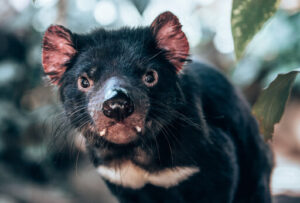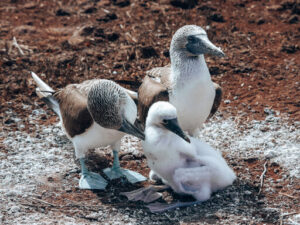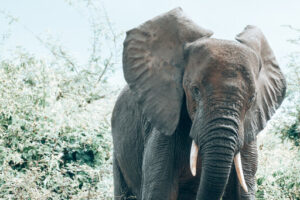With the fresh start of a new year, we believe this is the perfect moment to reflect upon the previous year. When we carefully reflect and learn from what’s in the past, we are able to direct the future into a better position, right?
Positive news for wildlife in 2020
What better way to start this article by sharing some positive news! Positive news about wildlife, that all took place in 2020. Because yes, 2020 has been a hard year for many, but some incredible things did take place in 2020. Time for some reflections!
The first positive item we like to share is about the Tasmanian devil. These mammals filled with temperament, got the name “devil” when the early European settlers saw acts like teeth-baring and heard horrifying growls coming from these mammals. Though this name makes this mammal come across as not being the kindest, this behavior supposedly solely comes up in the act of feeding or when fear plays a part.

In the late 1800s, the inhabitants tried to eradicate the Tasmanian devil, because the Tasmanian devil was supposed to be responsible for livestock killings. These efforts were rather successful, up until 1941 the government made the Tasmanian devil be a protected species. While the numbers of the Tasmanian devil were rising at first, tens of thousands of them died in the mid-1990s when a horrible illness spread rapidly among them. This illness got to the point of only 20.000 species remaining, which resulted in them being classified as endangered by the International Union for the Conservation of Nature.
Up until 2019, it was only found on the island state of Tasmania. But, as of 2020, the Tasmanian devil has returned to mainland Australia for the first time in millennia! A little over two dozen Tasmanian devils were taken to a sanctuary in Australia, but after a few months, they are now free. For the first time in 3.000 years, the Tasmanian devil rewilded to mainland Australia!
The second positive item we like to share has to do with pangolins. These mammals might be less known compared to the Tasmanian devil, though the pangolin is extremely unique! They have the amazing capability to curl into a ball and have an armor of scales, from tip to tail! Unfortunately, pangolins are often victims of illegal wildlife crime. This mostly takes place in Asia, but this happens more and more in Africa as well. Pangolins are victims of their crimes because of their meat and unique scales. Back in June 2020, China gave the native Chinese Pangolin the highest level of protection. This protection closed a loophole that maintained the consumption of pangolins within China. Besides this, China also doesn’t allow the use of scales from the pangolins for traditional medicine. Quite some incredible news, right?!

The last positive item we would like to point out is the direct impact of the coronavirus on the environment. We have probably all seen the images from satellites that showed us the difference in air pollution, displayed before the lockdown and during the lockdown. The reduction of the daily commute, and also almost no flights crossing from one place in the world to the other: our planet got a chance to recover. An additional benefit to the reduced daily commute got measured in the United States. The fatal collisions with wildlife (with for example elks) lowered by 58%! Also, the supposed source of the coronavirus to spread among humans can be taken into consideration. The first humans got infected on a market in Wuhan, which makes us rethink the way we handle wild animals. And to give another example is one that lays close to our hearts: the Galapagos Islands. Because of the tourism being paused on the islands, it opened up ‘doors’ for wildlife on the islands. Research has shown, for example, that the boobies (a species of sea birds) started nesting on the visiting trails. Obviously, before the lockdown occurred, this had never happened.

While some of these positive news items aren’t related to the coronavirus, many of them are. 2020 has given us a glimpse of what can happen when we treat our planet, and the wildlife with more respect, it makes us eager to do more. And trust us, there’s so much more possible!
Wildlife tourism before COVID-19
Because, if we open our eyes to how wildlife tourism mostly looked like before COVID-19, it makes our stomachs turn. In case you aren’t as familiar yet with the animal cruelty taking place in wildlife tourism, let us give you some examples:
The first, probably most known, example lays in animal cruelty and abuse in wildlife tourism. All (up-close) animal interactions are usually not as pleasant for the animals as they are for tourists. Especially for those animals who aren’t considered to interact in the same way as humans do. Examples of these cruelties are declawed and drugged tigers or shackled elephants. We get goosebumps while writing this, assuming you get this horrible picture. Another important example that needs to be taken into consideration is animal captivity. When taking a photo with a ‘kissing dolphin’: this dolphin is taken out of its natural habitat and the interactions with humans force the dolphin to stay in captivity. While captivity is one (rather horrible) aspect, we haven’t even discussed the aspect of ‘enough’ space for these animals. A study by World Animal Protection showed that 75% of 3.000 elephants lived in ‘severely cruel’ conditions. If we consider a lockdown to be horrible, imagine what these dolphins, elephants, or tigers might experience. A lifetime long. While wildlife tourism can be divided into five different categories, one of them includes wildlife sanctuaries. This type of wildlife tourism is, up until this point, considered to earn a positive score when it comes to animal welfare and conservation.

Green Stamp in 2021
With all of this being said: what is the Green Stamp going to focus on during 2021? As you might expect, we haven’t written this article, if it doesn’t have to do with our goals for 2021.
As some of you might know, the initial idea for the Green Stamp was to direct more travelers to ethical and ecological wildlife projects. This way travelers get a glimpse of what wildlife truly looks like, without harming either nature or animals! Obviously, we had to adjust our idea because of the global pandemic. Since freely traveling up until this moment still isn’t possible, we have the following ideas lined up. First of all, we want to continue and grow, the amazing “donate-for-free” as we do right now. So far, we have been able to gather some amazing donations, all by people simply doing their daily shopping through our website. It still amazes us to realize all these donations haven’t cost anyone anything extra!
Our second goal for the Green Stamp is going to be a course, fully created for wildlife projects worldwide that are ready to level up. This course will be for the projects that are ready to step up their conservation game and feel like they are ready to take their (online) marketing to the next level. The main theme for this course will be the pure preservation of wildlife and nature.

The third goal for the Green Stamp will refer back to its original idea: shift the culture in the way travelers make choices while picking a wildlife tour. Up until today, we feel there’s a lack of knowledge and awareness about the good, or the bad wildlife tours out there. For this, we truly can’t blame travelers. Though, we from the Green Stamp, do want to gap this bridge. We are aiming to reach more and more travelers worldwide and direct those who are ready to explore the true beauty of wildlife, to one of our wildlife partners.

Written by: Carmen Castricum


